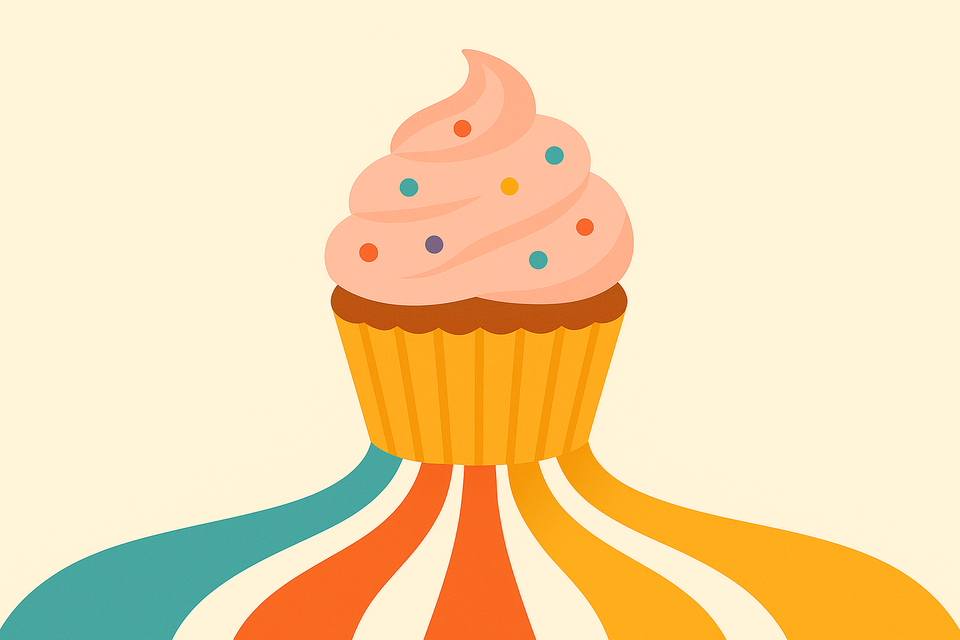From Catalogs to Kitchens

The Cupcake Phenomenon
We’ve noticed a shift in user behavior of consumers in the past year, driven by AI apps and agents, that both improves people’s experience on the Web while also driving down user engagement on web sites - cutting ad revenue. This has led to much angst in the industry & if it continues then sometime later this year it may lead to a Complete Utter Freakout. The cause? It's what we call the “Cupcake Phenomenon” and I explain it further in this article, describing where it is coming from, what is going to happen and what publishers (and eventually advertisers) should do about it. Let’s get cooking!
When you’ve used an AI app and asked for more than a quick fact, have you been surprised at how “fully baked” the response is? It may take half a minute, but what comes back often feels remarkably pleasant — comprehensive, even holistic. That unexpectedly good experience is forming new habits for consumers. Instead of stitching together fragments from different sites, people are starting to expect outcomes that meet their needs in one place. For publishers, that shift is destabilizing. The web used to reward verticals: narrow domains, optimized for search and ad yield. Now those structures feel misaligned with how people actually want to consume and use information. AI has shown that “horizontal integration” is possible, and once people experience it, they won’t go back. People are moving on. The only real choice for publishers and platforms is whether to follow them there or be left behind.
AI is shifting the baseline of what people expect when they turn to the web. People are learning that they can ask for outcomes — a party plan that lays out the menu with a shopping list, curates a playlist, suggests games, and picks a movie for the kids; or an upcoming ski trip that combines the weather forecast, ski conditions, lift ticket prices, gear rental options, condo accommodations, and travel times into a single plan. Instead of pulling together the raw ingredients, people are starting to expect something closer to a finished meal - like getting a cupcake instead of a cup of flour.
Each of these experiences would once have meant hunting across half a dozen sites. The shift is showing up in the data: Business Insider saw a 55% drop in organic search visits between 2022 and 2025, while traffic to the news category overall fell by more than 600 million visits in a year [WSJ]. User behavior tells the same story. Pew researchers found that when Google displayed an AI-generated summary, people clicked through to search-result links only 8% of the time, compared to 15% when no summary appeared. In more than a quarter of those sessions, the AI summary ended the search entirely [Pew].
That small shift of going from hunting to crafting is powerful. It turns content consumption into content usage. That creates agency, and once people experience that, it rewires habits. Simply browsing feels clumsy by comparison.
For two decades the web rewarded verticals. Publishers built around narrow subjects like sports, recipes, or gadgets because discovery systems favored specialization. Google’s ranking systems prioritize topic authority, rewarding deep coverage in areas like health or finance [Google, Search Engine Land]. Advertisers reinforced the pattern, paying higher CPMs for targeted audiences — healthcare content, for instance, often commands $15–$35 compared to $4–$12 for travel [Newor Media]. Verticals were easier to package for advertisers, easier to scale operationally, and easier to tune for SEO. The problem is that this structure was designed for distribution mechanics, not for user needs.
The difference is like flipping through the pages of a catalog — pots and pans in one section, ingredients in another, blenders, recipes, plates, flatware scattered throughout — versus walking into a well-stocked kitchen where everything you need is already at hand. A catalog forces you to assemble, compare, and decide. A kitchen is ready for use, built around the outcome you actually want.
For publishers and the platforms around them, this shift is unsettling. The vertical model was built for catalogs: each site neatly contained, monetized, and optimized in isolation. That structure doesn’t translate well when people expect kitchens, integrated experiences where the boundaries between subjects disappear. Advertising systems, identity frameworks, and subscription products that assumed vertical silos now look misaligned with user behavior. The result is that publishers risk becoming invisible. AI intermediaries can pull their content into horizontal experiences without attribution or revenue flowing back. Unless publishers reorganize how they present and package value, the outcome is that the user relationship and the economics that come with it will move elsewhere.
AI has shown people prefer outcomes, not fragments. This moment forces a choice. Publishers and the platforms that serve them can keep defending vertical silos, hoping that search and social traffic will return. Or they can adapt to the horizontal reality that AI has made obvious. The opportunity is to build or join networks that feel like kitchens, places where people can find what they need without friction. That might mean organizing content and value across subjects, federated subscriptions and payments, identity systems that work across domains, or ad monetization that recognizes a user’s broader journey instead of a single site visit.
The point is simple: the web isn’t broken, but the business models built for it are. Those who reorganize around how people actually use information will lead. Those who don’t will be absorbed into someone else’s feed.
Member discussion